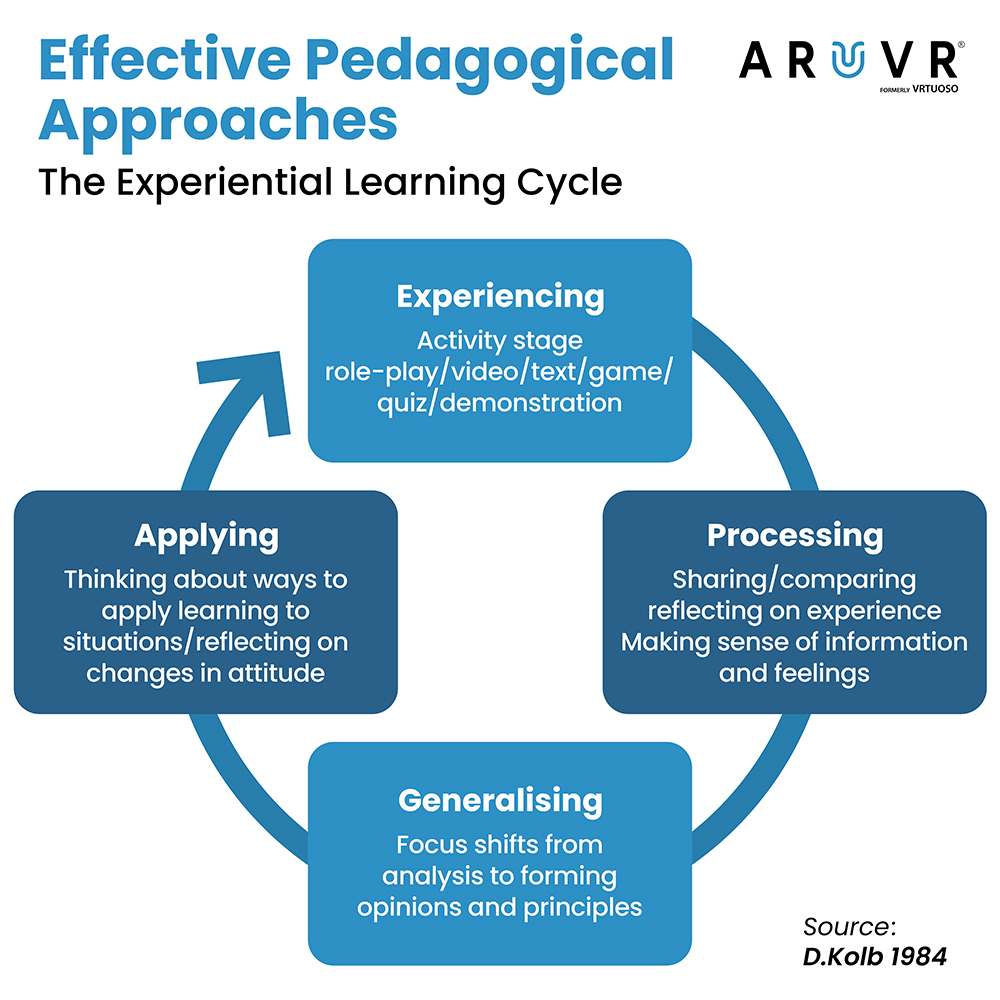How Does XR Empower Experiential Learning?
5 December 2023
I hear and I forget. I see and I remember. I do and I understand. — Confucius
Experiential learning remains a cornerstone of immersive training and a key advantage of using virtual, augmented, and mixed reality (VR/AR/MR) solutions.
With these theoretical techniques, institutions, companies, and organisations can rapidly up skill and onboard new hires, re skill current employees, and prepare the workforce for future vocational training.
Widely documented studies show technologies like extended reality (XR) can improve learner retention rates by 75 percent, train individuals four times faster, and build confidence 275 percent more compared to traditional reading and lecture-based instruction.
So why does experiential learning and XR go hand in hand? XR Today takes a closer look.

David Kolb and Experiential Training
Experiential learning has been shown in countless global studies around the world to be a key aspect of holistic teaching methods.
This is the practice in which direct experiences engage learners at the practical and sensory level to enhance cognitive learning skills at rates multiple times that of traditional instruction.
With it, instructors recognise that deep learning trumps surface-level learning by pragmatic, hands-on experience in education. Learners can complete tasks through several different methodologies, including discussions, rehearsals, and role-playing.
US Educational Theorist David Kolb, a progenitor of such theories, has developed his practices throughout the 80s and written extensively on the subject.

According to Kolb, this proceeds in several stages:
- Concrete experience such as learning to ride a bike, speak a language, or play an instrument.
- Reflective observation, or a learner thinking on the experiences they had, or observing others complete the task, during training courses.
- Abstract Conceptualisation, where learners then work on improving or developing action plans for their skills for a specific course of training.
- Active Experimentation by acting on knowledge acquired across the training course to complete tasks with greater efficacy.

According to research citing the Cohen scale, which measures the effect of a teaching method on learner retention, students averaged between 0.50 and 0.79, revealing a moderate impact on learner retention and efficacy.
This is equal to making huge impact on achieving targeted goals faster and with more accuracy.
Furthermore, following such theoretical practices are the backbone of tackling the upskilling challenges across the global workforce. Employees and remote workers require reliable, standardised solutions to build skills rapidly and within the targets of an enterprise’s requirements.
The XR Association continues to document the utility of experiential learning and extended reality, namely as workforces and companies work to overcome the ongoing skills shortage crisis.
Extended Reality and Experiential Learning
Immersive firms truly shine in the field of experiential learning as they leverage the power of spatial computing to engage learners in unprecedented ways.
For example, extended reality firms can allow designers to create holistic learning experiences and environments with bespoke, Gen AI user-generated content (UGC).
By doing so, instructors and developers can progress learners across the entire experiential learning cycle, leading to greater and more effective learner outcomes.
For immersive learning designers and content curators, it’s vital to incorporate these training methodologies into their experiences to produce the highest quality results for enterprises while, additionally, measuring success rates with learning management systems (LMS).
For example, it may become more relevant to hold the learner’s full attention with virtual reality by showing a high-definition video, training instructions, or role-playing scenario.
Afterwards, instructors can move to a virtual or mixed reality (VR/MR) space, where they can trial a digital twin of a working environment or other situation to assess reaction times and choices.
Finally, a curricula designer can then switch the headset to augmented reality (AR), where learners can then practice this in real-world environments with digital content overlayed on machines, recognised objects, or other places with spatially anchored information.
This inevitably leads to progressive learning throughout the entire learner journey, effectively producing learners that are focused on their target learning objectives.
ARuVR and XR Experiential Learning
XR training companies like ARuVR, Oberon Technologies, Rock Paper Reality, Meta, Lenovo, and many others are putting their hat in the ring by developing hardware, software, and solutions capable of bringing the full benefits of experiential learning to public use.
This has accomplished enormous, measurable successes across many industry verticals. Additionally, clarity in curricula design, training pedagogy, and progressive skill-building has led ARuVR to receive G-Cloud 13, Crown Commercial Services, and LPI accreditation for their technologies, leading to standardised solutions trusted by the global immersive learning industry
As XR hardware advances in sophistication, so will use cases associated with them. ARuVR realises the incredible potential that these devices can offer VR training firms, and we’re committed to monitoring and observing how this will take shape over the coming months
As the XR industry evolves over time and hardware like the Meta Quest Pro, Apple Vision Pro, HTC VIVE XR Elite, Lenovo VRX, and many others empower immersive learning firms, these feats will unlock greater potential for theory to come into practice, for the benefit of society.
This article first appeared on XRTODAY
Ready to Discover the power of XR?
Unlock the Full Potential of XR with ARuVR®: Discover More Today!
Book a Demo